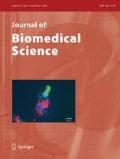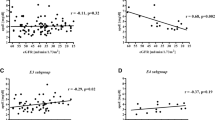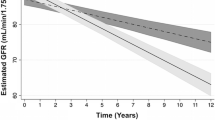Abstract
Objective: To study the association between apolipoprotein E (apoE) genotype and the rate of decline in glomerular filtration rate (GFR) in type 2 diabetic patients in a 9-year prospective study.Methods: GFR was determined in 84 type 2 diabetic patients by plasma clearance of51Cr-EDTA at baseline and after 9 years of follow-up. ApoE genotypes were determined by polymerase chain reaction and restriction enzymeHhal digestion and designated as ε4 allele group (apoE4/2, 4/3 and 4/4 genotypes; n = 20) and non-ε4 allele group (apoE3/3 and E3/2 genotypes; n=64). We focused our analysis on those patients who were more likely to progress to diabetic renal disease, i.e. whose GFR fell more than expected in the normal course of ageing [1 ml × min−1 × (1.73 m2)−1 per year.Results: In the whole population, the decline in the GFR did not differ statistically significantly between the apoE genotype groups [p=0.65 with analysis of variance for repeated variables (RANOVA) for interaction between apoE genotype group and time point]. However, among patients whose GFR changed more than 9 ml × min−1 × (1.73 m2)−1, GFR showed a statistically significantly greater decline in the ε4 allele group (n=11) than in the non-ε4 allele group (n=43) [from 116±36 to 80±29 ml × min−1 × (1.73 m2)−1 vs. from 119±20 to 96±18 ml × min−1 × (1.73 m2)−1; p=0.005 with RANOVA].Conclusion: ApoE allele ε4 may speed up the rate of decline of the GFR in patients with progressive diabetic renal disease.
Similar content being viewed by others
References
Araki S, Moczulski DK, Hanna L, Scott LJ, Warram JH, Krowlewski AS. APOE polymorphisms and the development of diabetic nephropathy in type 1 diabetes. Results of casecontrol and family-based studies. Diabetes 49:2190–2195;2000.
Ballard DJ, Humphrey LL, Melton LJ III, Frohnert PP, Chu C-P, O'Fallon WM, Palumbo PJ. Epidemiology of persistent proteinuria in type II diabetes mellitus. Population-based study in Rochester, Minnesota. Diabetes 37:405–412;1988.
Blaauwwiekel EE, Beusekamp BJ, Sluiter WJ, Hoogenberg K, Dullaart RPF. Apolipoprotein E genotype is a determinant of low-density lipoprotein cholesterol and of its response to a low-cholesterol diet in type 1 diabetic patients with elevated urinary albumin excretion. Diabet Med 15:1031–1035;1998.
Boize R, Benhamou P-Y, Corticelli P, Valenti K, Bosson J-L, Halimi S. ApoE polymorphism and albuminuria in diabetes mellitus: A role for LDL in the development of nephropathy in NIDDM? Nephrol Dial Transpant 13:72–75;1998.
Chowdhury TA, Dyer PH, Kumar S, Barnett AH, Bain SC. Genetic determinants of diabetic nephropathy. Clin Sci (Lond) 96:221–230;1999.
Chowdhury TA, Dyer PH, Kumar S, Gibson SP, Rowe BR, Davies SJ, Marshall SM, Morris PJ, Gill GV, Feeney S, Maxwell P, Savage D, Boulton AJM, Todd JA, Dunger D, Barnett AH, Bain SC. Association of apolipoprotein epsilon 2 allele with diabetic nephropathy in Caucasian subjects with IDDM. Diabetes 47:278–280;1998.
Collins VR, Dowse GK, Finch CF, Zimmer PZ, Linnanae AW. Prevalence and risk factors for micro- and macroalbuminuria in diabetic subjects and entire population of Nauru. Diabetes 38:1602–1610;1989.
Diamond JR, Karnovsky MJ. Focal and segmental glomerulosclerosis: Analogies to atherosclerosis. Kidney Int 33:917–924;1988.
Eto M, Horita A, Morikawa H, et al. Increased frequency of apolipoprotein ε2 allele in noninsulin dependent diabetic (NIDDM) patients with nephropathy. Clin Genet 48:288–292;1995.
Faronato PP, Maioli M, Tonolo G, Brocco E, Noventa F, Piarulli F, Abaterusso C, Modena F, de Bigontina G, Velussi M, Inchiostro S, Santeusanio F, Bueti A, Nosadini R. Clustering of albumin excretion rate abnormalities in Caucasian patients with NIDDM. The Italian NIDDM Nephropathy Study Group. Diabetologia 40:816–823;1997.
Friedewald WT, Levy RI, Fredrickson DS. Estimation of the concentration of low-density-lipoprotein cholesterol in plasma, without use of the preparative ultracentrifuge. Clin Chem 18:499–502;1972.
Garnett ES, Parsons V, Veall N. Measurement of glomerular filtration-rate in man using a51Cr-edetic-acid complex. Lancet i:818–819;1967.
Ha SK, Park HS, Kim KW, Kim SJ, Kim DH, Kim JH, Lee HY, Han DS. Association between apolipoprotein E polymorphism and macroalbuminuria in patients with non-insulin dependent diabetes mellitus. Nephrol Dial Transplant 14:2144–2149;1999.
Hixson JE, Vernier DT. Restriction isotyping of human apolipoprotein E by gene amplification and cleavage with HhaI. J Lipid Res 31:545–548;1990.
Horita K, Eto M, Mahino I. Apolipoprotein E2, renal failure and lipid abnormalities in noninsulin dependent diabetes mellitus. Atherosclerosis 107:203–204;1994.
Kasiske BL, O'Donnell MP, Cleary MP, Keane WF. Treatment of hyperlipidemia reduces glomerular injury in obese Zucker rats. Kidney Int 33:667–672;1988.
Keane WF, Kasiske BL, O'Donnell MP. Lipids and progressive glomerulosclerosis. Am J Nephrol 8:261–271;1988.
Kimura H, Suzuki Y, Gejyo F, Karasawa R, Miyazaki R, Suzuki S, Arakawa M. Apolipoprotein E4 reduces risk of diabetic nephropathy in patients with NIDDM. Am J Kidney Dis 31:666–673;1998.
Lam KSL, Cheng IKP, Janus ED, Pang RWC. Cholesterol-lowering therapy may retard the progression of diabetic nephropathy. Diabetologia 38:604–609;1995.
Lindeman RD, Tobin J, Shock NW. Longitudinal studies on the rate of decline in renal function with age. J Am Geriatr Soc 33:278–85;1985.
Meyer TW. Mechanisms of proteinuria in diabetic renal disease. Semin Nephrol 10:194–202;1990.
Mogensen CE. Microalbuminuria predicts clinical proteinuria and early mortality in maturity-onset diabetes. N Engl J Med 310:356–360;1984.
Mulec H, Johnson S-A, Björck S. Relation between serum cholesterol and diabetic nephropathy. Lancet 335:1537–1538;1990.
Onuma T, Laffel LM, Angelico MC, Krolewski AS. Apolipoprotein E genotypes and risk of diabetic nephropathy. J Am Soc Nephrol 7:1075–1078;1996.
Pettitt DJ, Saad MF, Bennett PH, Nelson RG, Knowler WC. Familial predisposition to renal disease in two generations of Pima Indians with type 2 (non-insulin-dependent) diabetes mellitus. Diabetologia 33:438–443;1990.
Siest G, Pillot T, Regis-Bailly A, Leininger-Muller B, Steinmetz J, Galteau M-M, Visvikis S. Apolipoprotein E: An important gene and protein to follow in laboratory medicine. Clin Chem 41:1068–1086;1995.
Ukkola O, Kervinen K, Salmela P, von Dickhoff K, Laakso M, Kesäniemi A. Apolipoprotein E phenotype is related to macro- and microangiopathy in patients with non-insulindependent diabetes mellitus. Atherosclerosis 101:9–15;1993.
Wellmann K, Volk BW. Renal changes in experimental hypercholesterolemia in normal and in subdiabetic rabbits. Lab Invest 22:144–155;1970.
Werle E, Fiehn W, Hasslacher C. Apolipoprotein E polymorphism and renal function in German type 1 and type 2 diabetic patients. Diabetes Care 21:994–998;1998.
Wirta O, Pasternack A, Laippala P, Turjanmaa V. Glomerular filtration rate and kidney size after six years disease duration in non-insulin-dependent diabetic subjects. Clin Nephrol 45:10–17;1996.
Wirta O, Pasternack A, Mustonen J, Laippala P. Renal and cardiovascular predictors of 9-year total and sudden cardiac mortality in non-insulin-dependent diabetic subjects. Nephrol Dial Transplant 12:2612–2617;1997.
Wirta O, Pasternack A, Mustonen J, Oksa H, Koivula T, Helin H. Albumin excretion rate and its relation to kidney disease in non-insulin dependent diabetes mellitus. J Intern Med 237:367–373;1995.
Author information
Authors and Affiliations
Rights and permissions
About this article
Cite this article
Lehtinen, S., Rantalaiho, V., Wirta, O. et al. Apolipoprotein E gene polymorphism, hypercholesterolemia and glomerular filtration rate in type 2 diabetic subjects: A 9-year follow-up study. J Biomed Sci 10, 260–265 (2003). https://doi.org/10.1007/BF02256061
Received:
Accepted:
Issue Date:
DOI: https://doi.org/10.1007/BF02256061




